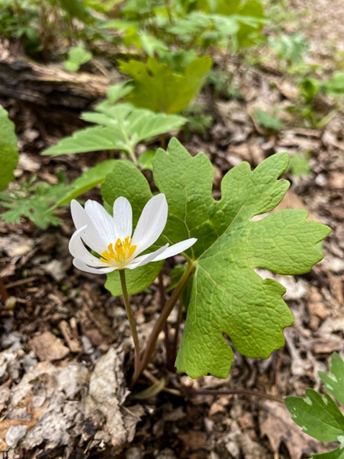Naturalist Notes: Spring Ephemerals – Nature’s Short-Lived Superstars
Written by Cathy Molitor, Naturalist at JNC
When you think of spring, do you picture a burst of colorful flowers waking up after a long winter snooze? While plenty of blooms make their debut in spring, there’s a special group of wildflowers that put on a dazzling—but oh-so-brief—show.
Meet the Spring ephemerals!
The word ephemeral comes from Greek and means "lasting a very short time". These flowers take that definition seriously. They pop up, bloom in a flash, go to seed, and disappear all before the trees fully leaf out and shade the forest floor. Most spring ephemerals bloom between late March and early May, then go dormant until next year. Blink, and you might miss them!
If you’re out exploring Johnson Nature Center this spring, keep your eyes peeled for these fascinating flowers:
Bloodroot
This plant earns its name from the red sap found in its roots. Unlike most spring ephemerals, which check out early, bloodroot sticks around until mid-summer before going dormant.
Trout Lily
Patience is key with this one! A Trout Lily won’t flower for the first four to seven years of its life, but its leaves are easy to spot. They’re green-gray with brown spots, resembling the speckled patterns of a brook trout—hence the name!
Large White Trillium
Trilliums are a Michigan classic, and with eight species in the state, they’re a true woodland treasure. The large white trillium, the most common, takes anywhere from 5 to 10 years to bloom. After pollination, its white petals develop a delicate pink blush—nature’s way of showing a job well done!
Marsh Marigold
Part of the buttercup family, this cheery yellow flower thrives in wet, wooded areas. It’s a favorite for hoverflies, which act as its primary pollinators.
Dutchman’s Breeches
These tiny white flowers look like little pairs of pants hung out to dry—hence the name! But not just any insect can pollinate them. Their nectar is hidden deep inside the elongated "pant legs," and only bumblebees have the strength and tongue length to reach it. Fun fact: The queen bumblebee, the sole survivor of her colony, emerges in spring and gets right to work visiting these flowers!
These short-lived beauties aren’t just a treat for us—they’re vital to the forest ecosystem. They provide much-needed nectar for early-emerging pollinators like bees and ants, which, in turn, help pollinate and spread their seeds. Plus, after months of snowy landscapes, they give us the first brilliant splash of springtime color.
So, lace up your hiking boots, hit the trails, and enjoy the fleeting magic of Michigan’s Spring ephemerals before they disappear for another year!
Bloodroot (Image from Prairie Moon Nursery)
Trout Lily (Image from Prairie Moon Nursery)
Trillium
Marsh Marigold (Image from USDA Forest Service)
Dutchman’s Breeches (Image from Everwilde Farms)





